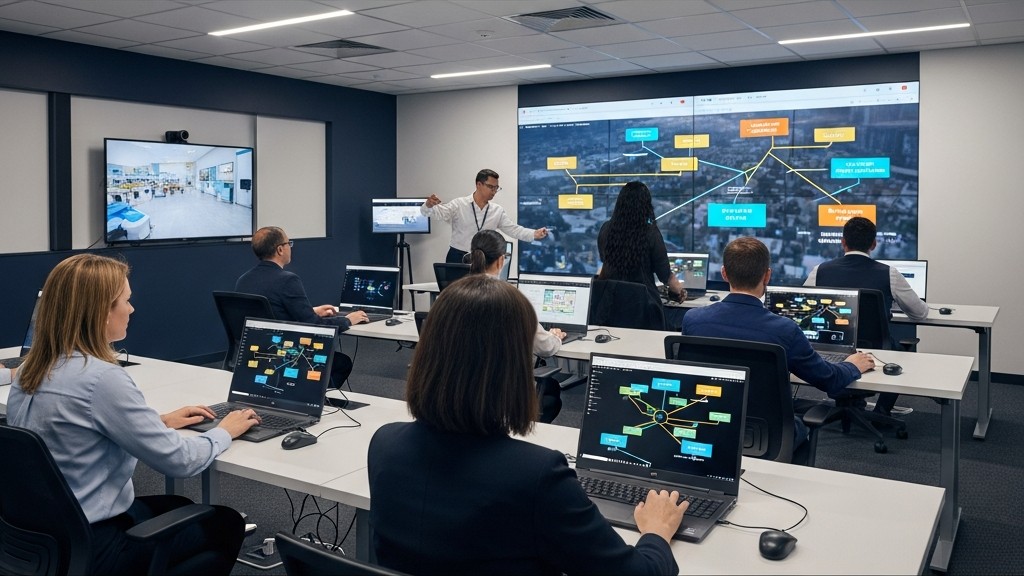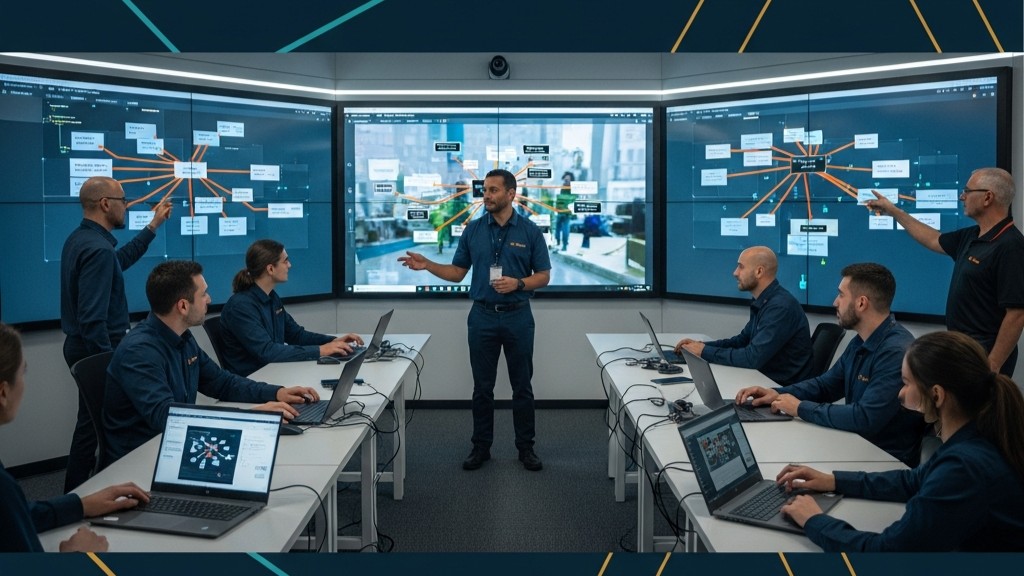What is a cybersecurity tabletop exercise?

Every minute, private and public organizations are at risk of experiencing a cyberattack. These attacks are evolving and only becoming more costly: financially, reputationally, and operationally. A high-impact cyber incident not only affects systems, but people—requiring organizations to ensure their preparedness.
Cybersecurity tabletop exercises do just that, helping organizations ensure that they’re ready for the expected and unexpected.
Read on as we cover how cybersecurity tabletop exercises work, key processes, practical insights, and answers to commonly asked questions.
Understanding cybersecurity tabletop exercises
Cybersecurity tabletop exercises simulate cyberattack scenarios in a structured, discussion-based forum. These exercises focus on strategic decision-making processes, helping key stakeholders navigate the complex challenges that emerge during security incidents—but within a safe environment.
A tabletop exercise should include any individual stakeholder or group that is critical to incident detection, response, communication, or recovery. Here are the roles different stakeholders fulfill during an exercise:
Facilitator: The facilitator’s role is to guide the exercise’s flow. This includes operating software and helping direct conversations to achieve the exercise’s objectives.
Incident response team (IRT): The IRT is ultimately responsible for managing and resolving the cybersecurity incident. In a tabletop exercise, they focus on strategic discussions—advising on detection, containment, and recovery—rather than performing hands-on technical actions.
Human resources (HR): HR’s role is to address employee concerns, from well-being support to disciplinary action.
Scribe: The notetaker’s responsibility is to document the exercise in real time, taking down discussion points, decisions (effective and ineffective), and action items. This documentation informs post‑exercise analysis and policy revisions.
Other key stakeholders may include communications teams, legal, executive sponsors, risk management teams, business continuity leads and exercise evaluators. Organizations generally conduct tabletop exercises at least once a year. They may add extra sessions after major system changes or in light of emerging cybersecurity threats.
How a cybersecurity tabletop exercise works: Steps and best practices
Here’s a look at how cybersecurity tabletop exercises work, step by step.
Step 1: Scenario presentation
Facilitators begin the exercise by setting the scene, then giving the background to a specific threat scenario. The scenario outlines key facts—threat vector, affected systems, and early indicators—while leaving room for discovery.
Collectively, participants confirm they understand the facts and ask clarifying questions. The scenario establishes a common reference point, primes decision‑makers, and frames objectives for the discussion that follows.
Step 2: Role-based discussion
Here, teams talk through the incident timeline chronologically, discussing each development and determining appropriate containment, communication, and recovery measures. Throughout the tabletop exercise process, it’s important that the facilitator doesn’t dominate the discussion. Their role is to help keep participants on track, while giving them the space to make independent decisions and actions.
As the exercise progresses, the facilitator alternates between presenting new scenario content and prompting discussion. This approach helps simulate the evolving nature of a real incident, allowing the conversation to adapt dynamically as new information emerges.
Step 3: Debrief and analysis
After finishing the exercise, teams reconvene to review their actions and outcomes. The facilitator guides a structured discussion that highlights what worked, where delays occurred, and which controls need refinement.
Participants and evaluators map decisions to actual policies and note any gaps in people, process, or technology. They then rank improvements by impact and feasibility, assign clear owners, and set timelines for follow‑up. The group closes by confirming dates for the next exercise, turning lessons learned into concrete progress.
Step 4: After-action report
After-action reports inform ongoing policy refinement. However, manual reporting is time-consuming and prone to human error. That’s why teams are increasingly relying on software. Tabletop exercise platforms make reporting faster, easier, and more accurate. These platforms passively collect exercise data, organize key findings, and automatically generate comprehensive after-action reports.
Common cybersecurity tabletop exercise scenarios
Tabletop exercises let businesses validate their response plans for any cyberthreat, from ransomware attacks and insider threats to supply chain disruptions and denial-of-service (DoS) attacks.
Ransomware attack: During a ransomware-focused tabletop exercise, participants walk through detection, containment, eradication, and restoration processes within a realistic yet safe environment.
Insider threat: Over 80% of businesses have experienced an insider attack, and this threat type is rising year after year. Tabletop exercises let key stakeholders validate detection, investigation, and remediation protocols.
Supply chain compromise: Whether due to natural disasters, supplier insolvency, or geopolitical unrest, tabletop exercises let key stakeholders accurately simulate supply chain disruption response plans.
DoS attack: From detecting anomalies and assessing impact to mitigating overloads and restoring service, tabletop exercises sharpen teams’ readiness for costly DoS attacks.
Ensure your organization’s preparedness, with Avalanche TTX
Avalanche TTX helps you mitigate evolving cybersecurity risk through dynamic, scenario-driven training and exercises. As an all-in-one solution, Avalanche TTX makes it easy for teams to design, execute, and review realistic simulations, far surpassing the limitations of traditional tabletop exercise systems.
With Avalanche TTX, you ensure your teams are equipped for the unexpected.
Learn more about Avalanche TTX today.
Frequently asked questions
What is a tabletop exercise example?
Businesses run tabletop exercises to ensure they’re prepared for evolving cyberthreats, including ransomware attacks. Ransomware-focused tabletop exercises let key stakeholders validate prevention, detection, containment, response, and restoration protocols at a strategic level.
How often should you conduct a cybersecurity tabletop exercise?
It’s common for businesses to run tabletop exercises annually. Those with a high threat exposure or complex regulatory obligations should conduct exercises more frequently; semiannually or quarterly. Additionally, businesses should conduct ad-hoc tabletop exercises in response to key stakeholder personnel changes, major system adjustments, notable security incidents, or new regulatory mandates.
What are the benefits of cybersecurity tabletop exercises?
The primary benefit of cybersecurity tabletop exercises is enhanced organizational incident-response readiness. An effective tabletop exercise lets key stakeholders simulate and validate cybersecurity response plans within a safe, non-consequential environment. Beyond preparedness, this also supports regulatory compliance and ongoing policy refinement.
Who should be involved in a cybersecurity tabletop exercise?
Cybersecurity tabletop exercises should involve all stakeholders who hold responsibility across key processes: prevention, detection, containment, recovery, and communication. This includes executive leadership, IT and security teams, legal and compliance personnel, and communications representatives.


